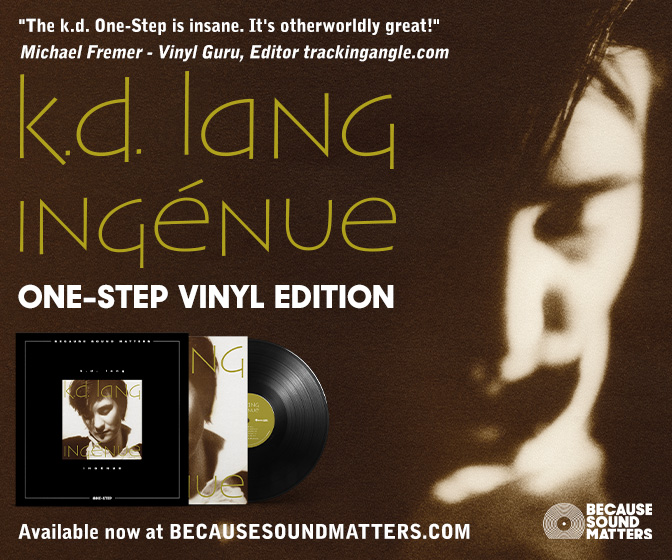Oasis Vinyl Reissues From Sony Japan: Any Good?
a sonic history of the biggest rock 'n' roll albums of the 90s
Is rock ’n’ roll about the music, or getting thrown off a ferry? Brothers Noel and Liam Gallagher probably never settled that argument (and likely never will), but Oasis’ legacy surrounds the music first and foremost, rock n roll antics and sibling rivalry second. While their rise represented a dated sense of 90s populist optimism, the tunes live on; nothing will desecrate the legacy of Noel's songwriting and Liam's distinctive voice on the first three albums.
Last summer, Sony Japan reissued those first three albums and the B-sides compilation The Masterplan as colored vinyl editions limited to 2000 copies each. Cut and pressed by Sony Japan mostly from the 2014-16 remasters, these are sumptuously packaged with obi strips, eight-page black and white Japanese booklets, and wonderful jacket stock (no tip-on jackets, though). Since Sony’s Japanese pressing plant is the best in the world, could these be the audiophile-grade Oasis pressings everyone’s been longing for? Or did they already exist all along?
Definitely Maybe
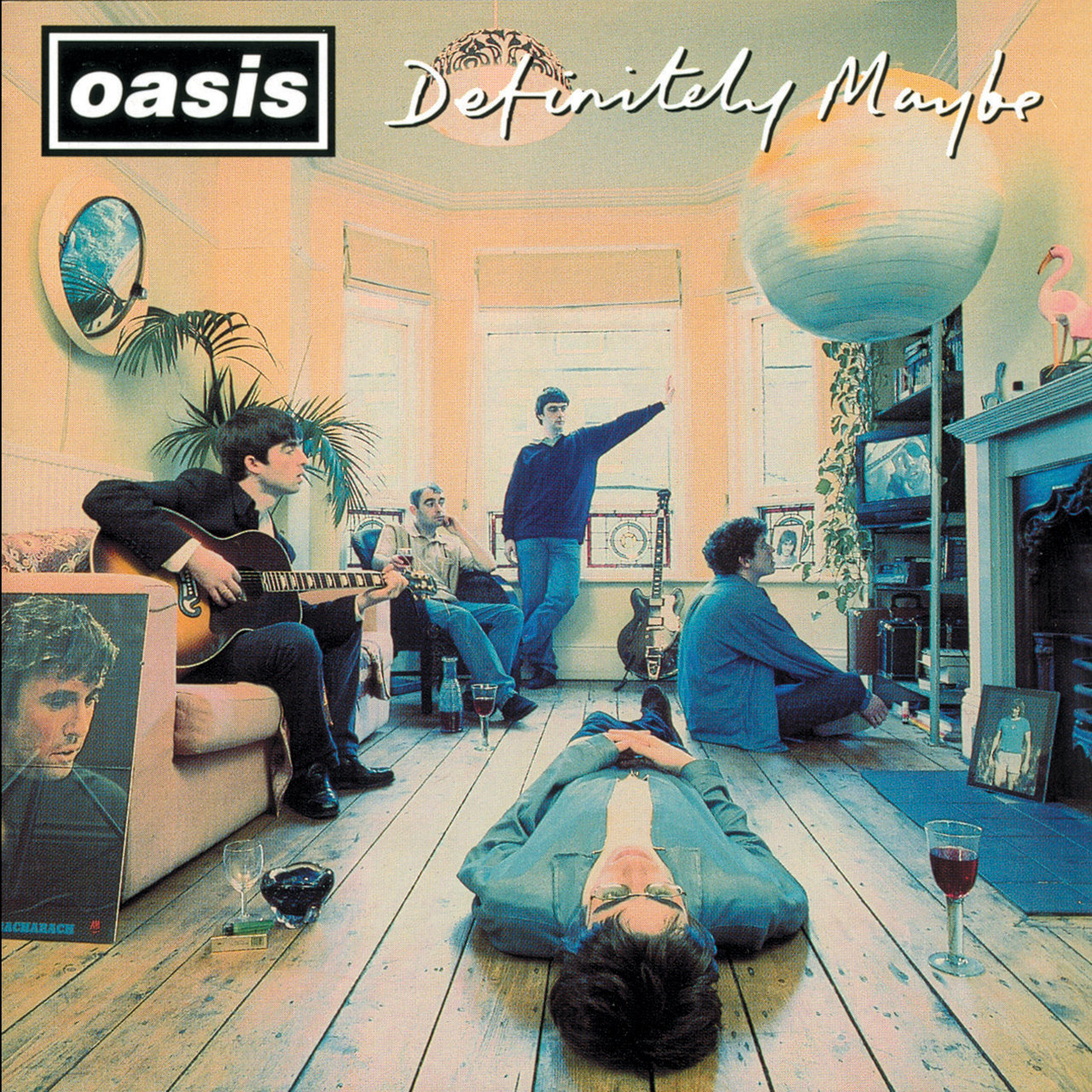
Sony Japan SIJP 1057-8 limited edition ivory vinyl 2LP
Produced by: Mark Coyle, Noel Gallagher, Owen Morris, Dave Batchelor
Engineered by: Mark Coyle, Owen Morris
Mixed by: Owen Morris, Mark Coyle, Dave Scott
Mastered by: Ian Cooper at Metropolis Mastering (2014 digital remaster)
Music: 9
Sound: 6
What is there to say about Definitely Maybe that hasn’t already been said a million times since 1994? Really, the less said about it the better; what makes it great is that it needs no explanation or dissection, you just listen and get it. It deserves all the praise thrown at it—without question, it is one of the greatest debut albums of all time, one of the greatest rock ’n’ roll albums, and one of the greatest, period. Rarely does a band arrive as fully formed as Oasis, with a batch of songs anywhere close to this. Definitely Maybe is song after song of pure excellence, the sound of a few working class Manchester guys dreaming a way out of the everyday dirge. They dreamed, and while they eventually lived beyond those dreams, the dreams were all they had for a while. No matter your background, they make you believe every last bit of it. When Noel writes and Liam sings “In my mind, my dreams are real/And now you’re concerned about the way I feel?/Toniiiiiiigggghhhhttt/I’m a rock and rOLL staaaarrrrrrr” on the opening “Rock N Roll Star,” you are fully convinced. Soon enough, the dream became real. Despite the tight marketing budget, Creation Records marketing man Tim Abbott strategically promoted it (particularly through ads in football and dance magazines) and it ended up getting five stars in publications ranging from the traditionally rock ’n’ roll NME to the dance-focused/guitar-ignoring Mixmag. Definitely Maybe hit #1 in the UK and became the fastest-selling debut album there, with Oasis being a sensation growing each day.
Since the music has already been written about from countless varying perspectives, for the sake of this feature I’ll focus more on the production and recording history. Signed to Alan McGee’s Creation Records (financially struggling due to poor management and McGee’s reported coke habit) in 1993, Oasis first attempted recording Definitely Maybe with producer Dave Batchelor, only to scrap those sessions and redo it with Noel and his friend Mark Coyle co-producing. Owen Morris was brought in to mix and finish the record; while not listed as a producer on Definitely Maybe, his job was more intensive than simply mixing the album. He used lots of effects and compression to achieve the dense final mixes, which he then mastered at Johnny Marr’s Clear studio (Morris recalls Marr being appalled by his mastering approach). It seems that the sessions were initially tracked to analog tape, transferred to DAT, then mixed back to analog tape; however, it’s likely that no album master was ever assembled so none of the vinyl editions were cut from any sort of analog tape.
I regard the original UK Creation CD as the original document, since the original UK Creation and EU Helter Skelter LPs were obviously cut from Morris’ CD-ready master (and therefore, in my opinion, aren’t worth the $200-ish market prices). Morris’ goal was to replicate Oasis’ live sound, which he achieved through mix and master compression as well as soft clipping on Apogee mastering converters that allowed an extra 6dB gain before distortion. That made the original Definitely Maybe CD the loudest on the market then, starting the “loudness war;” it was mastered to pop into the foreground wherever it was played, and despite traditional audiophile whining, is central to communicating these songs’ intent. That original UK CD absolutely rocks. There is no hiding from it, it is in your face but incredibly effective for the music. It might sound overly noisy in a car or budget system, but on a good system it sounds “fooking mega” as Liam might say.
In 2009, Oasis’ label Big Brother reissued the catalog on vinyl, cut by Miles Showell at Metropolis from remastered sources and pressed on super heavyweight vinyl likely at The Vinyl Factory (which uses presses from the old EMI Hayes-Middlesex plant, re-located nearby). Those reissues have gone up in price, probably because the 2009 Definitely Maybe remaster is the most immersive, smooth, detailed, “audiophile” take on the album. There’s mild inner groove distortion that’s unavoidable with Oasis as well as harsh sibilance plaguing the vinyl-only “Sad Song,” but it’s about half the cost of the original LP and an equal, maybe slightly superior alternative to the original CD.
The 2014 “Chasing The Sun” remaster ("Chasing the Sun" is the name of an Oasis reissue series) by Ian Cooper at Metropolis and supervised by Owen Morris is the source for all pressings since then, including this 2022 Japanese reissue pressed on ivory colored vinyl. Digitally, the 2014 remaster is passable though even louder than the original and a bit sterile. The project manager dropped the ball regarding “Slide Away,” using an alternate (wrong) mix that lacks some of Noel’s backing vocals from the original (this was not corrected on later pressings of the 2014 remaster). That’s a common issue with many albums from this era, since CDs didn’t require anyone to assemble a master album reel so the individual songs and their different mixes would all be on separate reels. Vinyl pressings of the 2014 remaster vary in cut and plating quality (the ones done at United in Nashville and Takt in Poland should be ignored completely); I have the Japanese pressing and a 2023 reissue cut by John Davis at Metropolis and pressed at Pallas (identifiable from the double-scored seams of the gatefold jacket). I obtained the latter in a Portland record shop for $29, so I assume it’s becoming the international standard at least for a few months.
Of the 2022 Japanese reissues, Definitely Maybe is one of the better ones, though all of them share a few common issues. Whoever cut these reissues at Sony’s Japanese mastering house rolled off the bass and boosted the top end in attempt to mine “space” and “detail” that isn’t (and shouldn’t be) there to begin with. Inner groove distortion starts about halfway through the playback range of the side (not necessarily halfway through what’s cut), and the severe lack of the lowest octaves makes this midrange-dense recording sound like a one-dimensional wall of noise with Liam singing in front of it. Oasis’ sound is supposed to be an impenetrable wall of guitars, yes, though at least on the original CD and 2009 vinyl there’s depth to it that’s missing on this fatiguing Japanese cut. That said, Sony Japan’s vinyl formulation and quality control remains the absolute best in the world, and the package comes with an obi strip and an 8-page black and white booklet featuring Japanese liner notes and translations. It's also worth noting that all versions of the 2014 remasters feature different artwork layouts than the originals, while the 2009 copies replicate the originals.
If you’re on a budget but desperate for a vinyl copy of this, the new John Davis cut pressed at Pallas is the best you’ll get for $30 or less. While the 2014 remaster isn’t great, this cut has more depth and separation and less distortion than the Japanese one. It even gets close to the 2009 on some tracks while the 2009 obliterates it on others; still, this is the best way to hear the alternate “Slide Away” and “Sad Song” is better and less sibilant here than on the 2009 pressing. The Pallas black vinyl is excellent as usual and comes in poly-lined inner sleeves. I still prefer the original CD but recommend the new Pallas pressing for those not in the market for a $100 record. (The Japanese pressing gets the 6/10 sound score above. The 2009 pressing gets a solid 8 while the recent John Davis cut gets a 7.)
(What’s The Story) Morning Glory
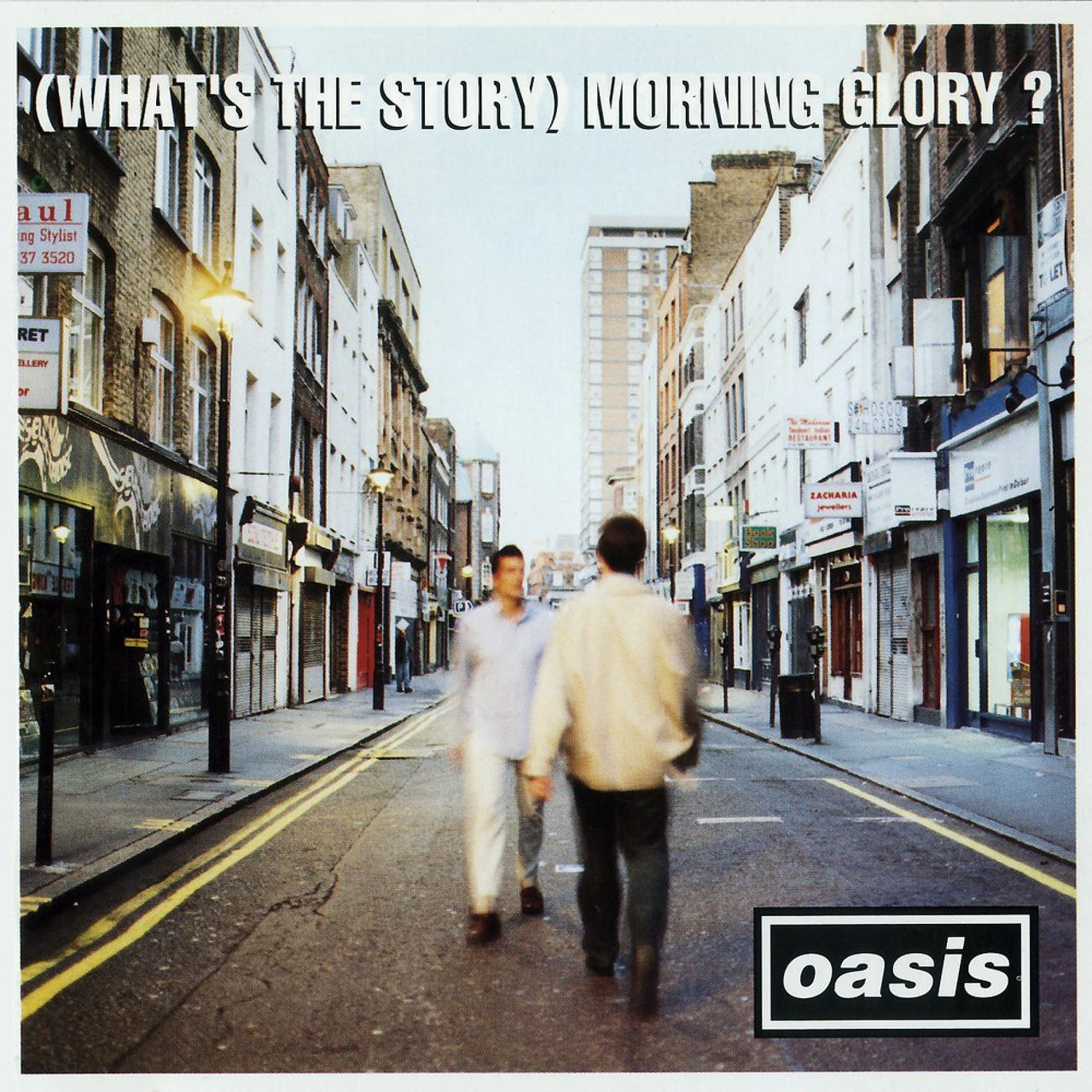
Sony Japan SIJP 1059-60 limited edition white vinyl 2LP
Produced by: Owen Morris and Noel Gallagher
Engineered by: Uncredited (Owen Morris)
Mixed by: Owen Morris
Mastered by: Ian Cooper at Metropolis Mastering
Music: 8
Sound: 6
Released in October 1995, Oasis’ second album (What’s The Story) Morning Glory turned Oasis from “just” a big rock band to the biggest band in the world for about two years. It made them rock gods in the UK, broke them through to the American mainstream, and even if you’ve never gone out of your way to listen to it, you’ve already heard half the album. The songs are more musically dynamic than Definitely Maybe; more anthemic, with enough rock ’n’ roll grit to keep it compelling but not so much to repel anyone. It’s also a bit more rhythmic, thanks to drummer Alan White who replaced Definitely Maybe drummer Tony McCarroll (unceremoniously kicked out by Noel). It’s a band at the height of their importance, but it’s also the least interesting of the first three Oasis records. There’s more filler—the redundant “Hey Now” or the rather throwaway “She’s Electric”—and everyone’s heard “Wonderwall” too many times, but you still can’t argue against a record with epics like “Champagne Supernova,” “Some Might Say,” and “Don’t Look Back In Anger.”
In the gap between Definitely Maybe and Morning Glory, a small bootleg label seized the attention and money of hungry fans by releasing the 14-minute "Wibbling Rivalry" single (the name printed on the sleeve is Oas*s). It’s not even music, rather it’s a recording of NME’s John Harris interviewing Noel and Liam as they argue about the latter’s getting drunkenly thrown off a ferry. Oasis mania was so intense that "Wibbling Rivalry" charted at #52 on the UK Singles Chart; it’s a hilarious listen and worth owning on the CD or 7” single which can be found for cheap.
The original Morning Glory CD, again mastered loud by producer Owen Morris to ease his insecurities about his mixes, has EQ imbalance between channels and lots of midbass and lower midrange mud. It sounds more dynamic than the 2014 remaster, but I prefer the brighter remaster. However, this Japanese cut is again a missed opportunity, as any bass is rolled off and it’s cut too hot. The tri-fold package is nice, though, and the white vinyl is the quietest white vinyl I’ve heard. Like Definitely Maybe, there’s also a new pressing of Morning Glory cut by John Davis and pressed at Pallas; I haven’t heard it, but I’d recommend getting that or the 2009, which I also haven’t heard. An original pressing costs an arm and a leg and was cut from the CD master anyway. Why waste your money?
Be Here Now
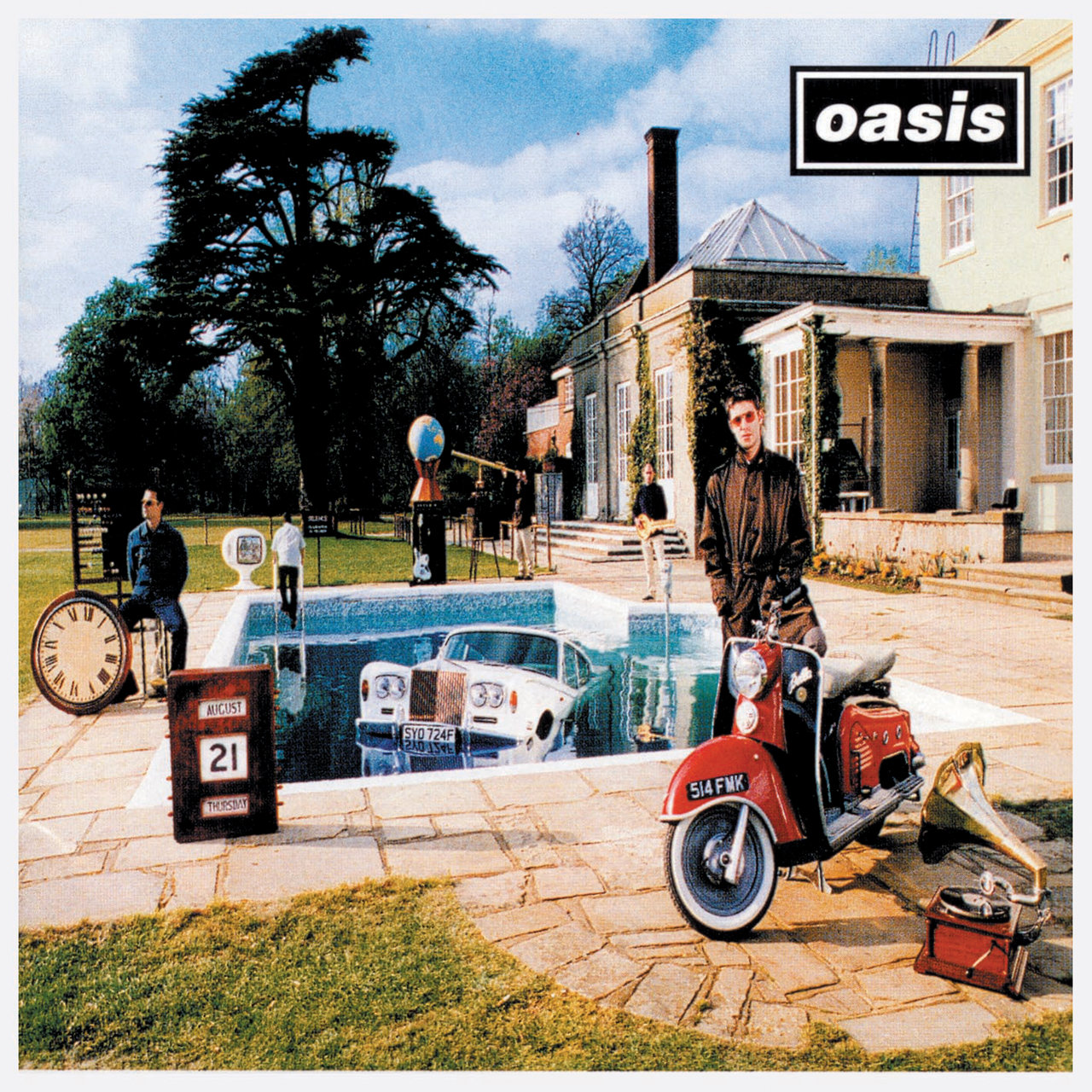
Sony Japan SIJP 1061-2 limited edition red vinyl 2LP
Produced by: Owen Morris and Noel Gallagher
Engineered by: Uncredited
Mixed by: Owen Morris
Mastered by: Ian Cooper at Metropolis Mastering (2016 digital remaster)
Music: 8
Sound: 5
“You might as well do the white liiiiiiine…” Liam drawled on “Cigarettes & Alcohol.” And, as the biggest rock band on the face of the earth, Oasis certainly did. A lot, in fact. Two headlining nights at Knebworth in summer 1996—they played to 250,000 fans in total, though 2.5 million applied for tickets—secured their status as untouchable legends, and what did they have to lose? As the popular narrative goes, the ensuing storm of coke-fueled ego resulted in Be Here Now, a comically overproduced, self-indulgent album that once the massive hype settled, exposed itself as a catastrophic failure. “It’s the sound of a bunch of guys, on coke, in the studio, not giving a fuck,” Noel famously said in the 2003 Britpop documentary Live Forever. The anticipation was unprecedented, and the promotional rollout chaotic. Critics originally lukewarm on (What’s The Story) Morning Glory rushed to overcorrect themselves, throwing endless praise towards Be Here Now while fans lined up outside record shops on Thursday, August 21, 1997—a date apparently so historic that it’s printed on the album cover. (For more on this insanity, I highly recommend reading Angus Batey’s piece in The Quietus.)
Yet Be Here Now is legitimately a great album, albeit not what masses wanted to hear or accept. Just as John Lennon declared the 1960s “dream” as “over” on Plastic Ono Band, Be Here Now is Noel Gallagher coming to terms with his new reality: the dream, of Oasis’ success and the larger Britpop idea overall, remained exactly that, and for a few brief years, everyone else happened to share that dream. Idealism has an expiration date, and that expiration date occurred less than two weeks after the album’s release, when Princess Diana died in that car crash. Be Here Now didn’t end Britpop, rather it exposed the cracks beneath the coke-dusted surface. Yes, it’s brilliantly overproduced with dozens of guitars blaring at once and choruses repeated two or three times more than necessary. It’s also, in a sense, the most substantive Oasis album that deserves a patient reevaluation.
Liam loves it because it sounds fucking massive, while Noel dismisses it because he thinks the songs are inherently shit. It’s true that he wrote them in a much different setting; he wrote the first two records along the docks in Manchester, but wrote Be Here Now while staying at Mick Jagger’s villa in Mustique. A couple of the songs are indeed throwaways—the nonsensical but fun “Magic Pie,” or the meandering “Fade In-Out” which has Johnny Depp on slide guitar—though most of it’s gold. “D’You Know What I Mean” reprises the “Wonderwall” chord progression with a grandiose display of rock star excess (helicopters! strings! fifty billion guitars!) that also alludes to heavier topics, such as when UK tabloid News Of The World attempted to reunite Noel and Liam with their estranged, abusive father (“I met my maker/I made him cry/And on my shoulder he asked me why his people won’t fly through the storm/I said, ‘Listen up man, they don’t even know you’re born’”). Beneath the layers of anthemic guitars, songs like “Stand By Me” and “I Hope, I Think, I Know” sound vulnerable, wrapped with the fear of the glory completely crashing down.
On paper, “All Around The World”—among the first Oasis tracks Noel wrote in around 1992—seems like a simplistic singalong, though in the setting of Be Here Now is more emotionally complex. Lines like “These are crazy days but they make me shine/Time keeps rolling by” and “What you gonna do when the walls come falling down? You never move, you never make a sound” hold the anxieties of aging, the desire to hold onto those naive dreams of youth. Sure, the multiple key changes, elaborate string and horn arrangements, excessive repetition, and ridiculous animated music video (“Is that a man with legs made of sausages? That’s not real!!!”) don’t make the best impression, but the nearly 10-minute length isn’t a problem. If Definitely Maybe was a record of aspiration and Morning Glory a moment of accomplishment, Be Here Now is an album of uncertainty. Despite a few minor faults, it’s the summation of the full Oasis story in one record. The rise, the fall, the dreams, the dark reality: it’s all there if you’re willing to look for it.
Mike Marsh at The Exchange mastered the original CD and DMM vinyl, and said that he had to significantly increase bass and treble on Owen Morris’ mixes. The original CD is mastered even louder than the first two albums, but with solid detail and good tonal balance even if the highs sound a bit too sharp. For the 2016 remaster, however, Ian Cooper and Owen Morris decided that Marsh’s EQ was the problem on the original, so they didn’t EQ it yet compressed and limited the shit out of it. That was a terrible error in judgement. All versions based on the 2016 remaster are awful in every aspect; it’s just thick midrange sludge with no clarity or musical foundation. The bass is hardly there, and the lack of EQ means it registers as even less dynamic than the original (I’m sure the measurements say the same). The Japanese red vinyl pressing pulls Liam’s voice forward but turns the rest into white noise; even then, Liam’s voice gets distorted pretty fast, such as on “All Around The World” (first song on side four) when it’s slightly distorted right from the first line. It just sounds wrong. But the vinyl is dead quiet—not that you’d pick up on any surface noise anyway—and it looks cool!
Easily the best Be Here Now is the 2009 vinyl reissue cut by Showell. The top end is more natural than the original CD, bass is present when it needs to be, there’s actually some semblance of dynamics, and it has the most instrumental separation I’ve heard on this album. It’s very detailed but not in a clinical way. The vinyl is also very quiet on the copy I got used in near mint condition. The 2009 reissue is climbing in price but it’s a much better value than the original that Mike Marsh cut from his CD master. At that point you might as well buy the CD for $5 at most. (Hamish McBain’s liner notes on the 2009 pressing are overly critical, but makes sense considering the money probably came from Noel.)
The Masterplan
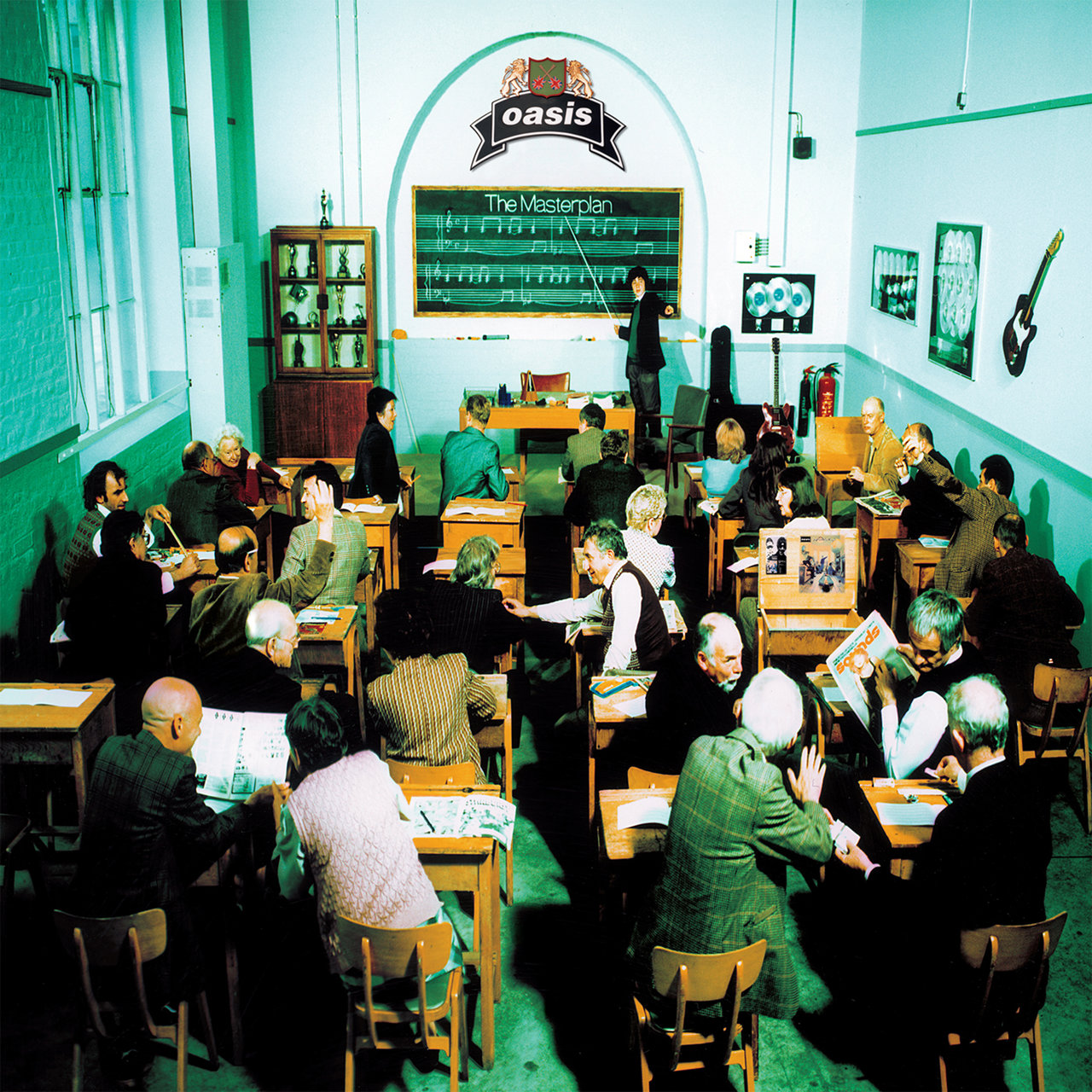
Sony Japan SIJP 1063-4 limited edition green vinyl 2LP
Produced by: Owen Morris and Noel Gallagher
Engineered by: Uncredited
Mixed by: Owen Morris
Mastered by: Uncredited (Ian Cooper?)
Music: 8
Sound: 7
While Oasis’ 90s studio albums and single A-sides made them superstars, their B-sides cemented a fanbase so loyal that fans defend present-day Noel hiring a scissors player or Liam spam-tweeting “bumbaclarts.” Noel believed that those buying the singles deserved equally good B-sides, though for less attentive fans, those CD singles might’ve seemed redundant, or if you were American, impossible to obtain. Released internationally in 1998, the Noel-curated B-sides compilation The Masterplan features 14 tracks that obliterate most artists’ greatest hits. Oasis didn’t burn bright for long, but the amount of A-tier output in those early years still astounds.
I won’t go song by song or single by single but generally, it was Noel’s more vulnerable songs that became B-sides; if many of the A-sides and album tracks were more broad and anthemic, the B-sides felt more personal, more world-weary. Similar to how the Be Here Now album tracks show a crashing back to reality, many of the early B-sides here depict the day-to-day tedium and traumatic pasts from which the rock ’n’ roll dream was a vehicle to escape. “But I don’t believe in magic/Life is automatic/But I don’t mind being on my own,” Liam sings on “Listen Up,” while “Fade Away” has the hook “While we’re living, the dreams we have as children fade away.” Both of those songs appeared on the “Cigarettes & Alcohol” CD single alongside a live “I Am The Walrus” cover. The “Walrus” cover isn’t very good, but still, has anyone ever put out a better CD single? Probably not. There are also a few Noel-led ballads on The Masterplan, such as “Talk Tonight” (“Some Might Say” B-side), “Half The World Away” (“Whatever” B-side), and the title track (“Wonderwall” B-side). The throwaways (“The Swamp Song,” “I Am The Walrus,” “Headshrinker”) are exactly that, though The Masterplan also shines light on tracks like “Stay Young” and “Going Nowhere” (both -era B-sides that rival anything on that album). Anyone who cares about Oasis needs these 90s B-sides, and The Masterplan is a great compilation with most of the best.
The original CD and vinyl editions (a standard 2LP as well as a box of seven 10”’s featuring one song per side) were mastered by Mike Marsh, and fixed some of the issues present on some of the original masters. For example, Marsh’s EQ is much better than Owen Morris’ original mastering on the tracks from the “Cigarettes & Alcohol” single. Loud, of course, but good. The 2022 Japanese vinyl reissue, pressed on translucent emerald green vinyl, was cut from the 2009 remaster not released digitally (maybe done by Ian Cooper?), and sounds the best of the Japanese pressings. Still, the original CD is better, as the cutting engineer at Sony Japan lopped off all the bass and cut it way too hot. It’s not terrible if you have a high-end cartridge that’s very precisely set up, but the inner groove distortion on “Going Nowhere” and “The Masterplan” is seriously intrusive. Of course, the vinyl is dead quiet and the packaging (a more matted jacket texture with printed inner sleeves) is great. This has to be better than the current standard edition pressed at Takt Direct (an absolute joke of a pressing plant—send lacquers there and you might as well throw them in the garbage). Stick with the original (CD or vinyl) or the 2009 vinyl reissue, but this isn’t a bad option.
By the time The Masterplan dropped, almost everyone had moved on, though in retrospect the issue was less about the tunes than the societal mood at the time. After Be Here Now, Oasis fell off a cliff, with Noel’s songs turning dull and Liam starting to sound like Kermit The Frog. They made a slight musical comeback on 2008’s Dig Out Your Soul, but imploded in a backstage fight between the Gallaghers in 2009. Maybe a reunion will happen, maybe not. Who knows, and really, who cares. Many bands don’t even last for three or four albums, much less three or four (depending on how you count) albums this great.





